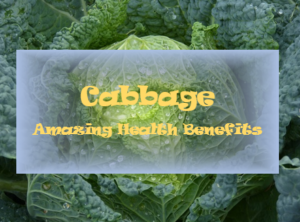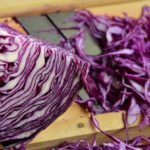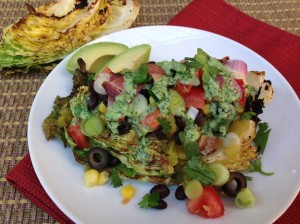 What comes to mind when you hear the word “cabbage?”
What comes to mind when you hear the word “cabbage?”
If all you can think of is coleslaw, you are likely missing out on some truly delicious meals, not to mention the AMAZING nutrition and health benefits this cruciferous vegetable provides!
This is why cabbage is the Superfood of the Month!
Why cabbage?
- Highest amount of some of the most powerful antioxidants found in cruciferous veggies. (Remember, cruciferous veggies, including broccoli, cauliflower, brussels sprouts and bok choy, are the #1 cancer fighters — see our coaching tip for more info.) Cabbage helps protect against several types of cancers including breast, colon, and prostate.
- Cabbage, especially purple cabbage, has anti-inflammatory effects and inhibits tumor blood vessel formation.
- Lowers cholesterol and helps prevent heart disease.
- Cabbage is an excellent source of fiber, Vitamin K, Vitamin C, calcium, potassium and magnesium.
- One cup of shredded raw cabbage has less than 50 calories and contains up to 5 grams of fiber.
- Insoluble fiber in cabbage helps prevent constipation and helps maintain a healthy gut.
- If the nutrition factor was not enough, there is one more reason to choose cabbage…it is extremely affordable!
What are the types of cabbage?
 There are several varieties of cabbage, each with unique features!
There are several varieties of cabbage, each with unique features!
- Green cabbage: the most common variety and the one most people think of.
 Purple (or sometimes referred to as red) cabbage: typically has smaller and denser heads vs. the typical head of green cabbage. Purple cabbage has more Vitamin A and C compared to green cabbage. Purple cabbage also contains powerful antioxidants, called anthocyanins, which give it its signature color, and are extremely powerful in protection from chronic disease and help fight inflammation.
Purple (or sometimes referred to as red) cabbage: typically has smaller and denser heads vs. the typical head of green cabbage. Purple cabbage has more Vitamin A and C compared to green cabbage. Purple cabbage also contains powerful antioxidants, called anthocyanins, which give it its signature color, and are extremely powerful in protection from chronic disease and help fight inflammation.
 Savoy cabbage: known as the prettiest variety of cabbage, it is loaded with Vitamin A, calcium, iron and potassium. Savoy cabbage has crinkled leaves and a more delicate texture, making it ideal to use for wraps or for stuffed cabbage.
Savoy cabbage: known as the prettiest variety of cabbage, it is loaded with Vitamin A, calcium, iron and potassium. Savoy cabbage has crinkled leaves and a more delicate texture, making it ideal to use for wraps or for stuffed cabbage.
- Napa cabbage: sometime referred to as Chinese cabbage, napa cabbage
 has a mild flavor and can have a slight peppery kick. It is the most tender and wilts very quickly. Napa cabbage also caramelizes well, so it is ideal to saute, roast in the oven or cook on the grill.
has a mild flavor and can have a slight peppery kick. It is the most tender and wilts very quickly. Napa cabbage also caramelizes well, so it is ideal to saute, roast in the oven or cook on the grill.
How to you choose the best cabbage?
You want to select cabbage that is firm and dense, and has tightly packed leaves (except for napa cabbage, its leaves should be ruffled, fresh and crisp). You also want cabbage that has shiny crisp leaves, with no cracks or bruises. Remember, the outside leaves don’t have to be perfect since you can peel them off. And, ideally it is best to choose cabbage that is free from pesticides. Pre-shredded cabbage is extremely convenient, but keep in mind, once cabbage is cut, it starts to lose its Vitamin C content. (If buying pre-shredded is the only way you will include it in your routine, then by all means, go for it! You will still be getting a ton of nutrition benefits.)
How do you store cabbage?
It is best to store cabbage in a plastic bag in the crisper drawer of your refrigerator. Red and green cabbage will keep for about 2 weeks, and savoy and napa cabbage will keep for about one week.
What do you do with cabbage?
 The easiest way to include more cabbage into your meals is to enjoy it raw and shredded, added to salads, but there are many more ways to make the most of this powerful veggie!
The easiest way to include more cabbage into your meals is to enjoy it raw and shredded, added to salads, but there are many more ways to make the most of this powerful veggie!
- Saute or Braise it! Cabbage adds a great flavor and crunch to stir fry dishes and skillet meals…try these recipes: Peanut Cabbage Stir Fry, Turmeric Pork and Cabbage Skillet, Bulgogi, Asian Style Sloppy Joes, Braised Red Cabbage with Apples, and Deconstructed Cabbage Rolls.
- Grill it! Believe it or not, you can grill cabbage! The grill adds a delicious crisp tenderness to
 wedges of cabbage — we love grilling savoy cabbage for the Southwest Wedge Salad.
wedges of cabbage — we love grilling savoy cabbage for the Southwest Wedge Salad.
- Roasted! We also love cabbage roasted in the oven. Roasting it adds a caramelized flavor that is incredibly good…and so simple too…olive oil, salt and pepper produce great results in our Roasted Cabbage.
- Soup’s On! Cabbage is also excellent when added to soups — try savoy cabbage in the Tuscan Bean Soup and green cabbage in one of our favorites, the Slow Cooker Borscht Stew.
 Roll it up! Cabbage can be an excellent wrap or works great as the filling too — try our Tuna Lettuce Wraps with Horseradish Dressing or Rainbow Veggie Spring Rolls.
Roll it up! Cabbage can be an excellent wrap or works great as the filling too — try our Tuna Lettuce Wraps with Horseradish Dressing or Rainbow Veggie Spring Rolls.
- Ferment it! Sauerkraut is another delicious and healthy way to enjoy cabbage, but keep the portions small because the amount of salt used in the fermenting process makes it high in sodium. A couple of great tasting recipes are the Oktoberfest Inspired Potato Skins and Open Faced Steak Reuben.
Our favorite trick?!
Zonya and I both consider cabbage, green and purple, to be a staple and keep it on hand all the time. We store it in the vegetable drawer of the frig and add it to salads and stir-fries frequently. This way, we can easily add a delicious cruciferous crunch to our meals with minimal effort!
Take the Superfood Challenge and try to include a variety of cabbage in your meals — and break free from the coleslaw rut! Then, let us know your successes and your favorite way to enjoy cabbage!
 LEARN MORE ABOUT THE NAPKIN!
LEARN MORE ABOUT THE NAPKIN!






Crazy, our soup du jour today is Braised Red Cabbage and Green apple soup!
Sounds absolutely delicious! Wish we were there to have a bowl!